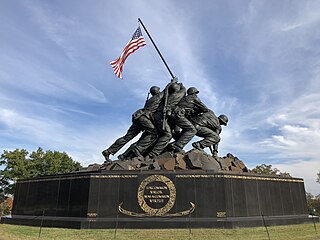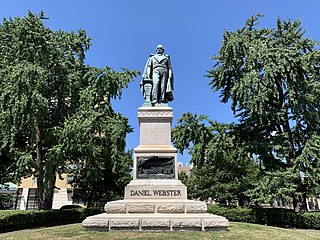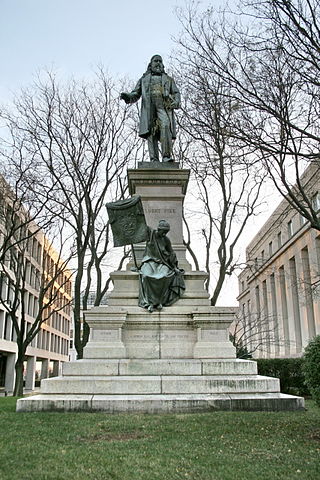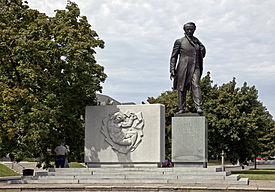
The United States Marine Corps War Memorial is a national memorial located in Arlington County, Virginia. The memorial was dedicated in 1954 to all Marines who have given their lives in defense of the United States since 1775. It is located in Arlington Ridge Park within the George Washington Memorial Parkway, near the Ord-Weitzel Gate to Arlington National Cemetery and the Netherlands Carillon. The memorial was turned over to the National Park Service in 1955.

Taras Hryhorovych Shevchenko was a Ukrainian poet, writer, artist, public and political figure, folklorist and ethnographer. He was a fellow of the Imperial Academy of Arts and a member of the Brotherhood of Saints Cyril and Methodius. He wrote poetry in Ukrainian and prose in Russian.

Paula Jon Dobriansky is an American diplomat, public official, and foreign policy expert who served as Under Secretary of State for Global Affairs (2001–2009) and the President's Envoy to Northern Ireland (2007–2009). A specialist in Central/East European affairs and the former Soviet Union, trans-Atlantic relations, and political-military affairs, Dobriansky held key senior roles in the administrations of five U.S. presidents.

Rivne is a city in western Ukraine. The city is the administrative center of Rivne Oblast (province), as well as the surrounding Rivne Raion within the oblast. Administratively, Rivne is incorporated as a city of oblast significance and does not belong to the raion. It has a population of 243,873.
National Mall and Memorial Parks is an administrative unit of the National Park Service (NPS) encompassing many national memorials and other areas in Washington, D.C. Federally owned and administered parks in the capital area date back to 1790, some of the oldest in the United States. In 1933, they were transferred to the control of the National Park Service. These parks were known as the National Capital Parks from their inception until 1965. The NPS now operates multiple park groupings in the D.C. area, including National Capital Parks-East, Rock Creek Park, President's Park, and George Washington Memorial Parkway. National Mall and Memorial Parks also provides technical assistance for the United States Navy Memorial.

The Victims of Communism Memorial is a memorial in Washington, D.C. located at the intersection of Massachusetts and New Jersey Avenues and G Street, NW, two blocks from Union Station and within view of the U.S. Capitol. The memorial is dedicated "to the more than one hundred million victims of communism". The Victims of Communism Memorial Foundation says the purpose of the memorial is to ensure "that the history of communist tyranny will be taught to future generations." The Memorial was opened by President George W. Bush on June 12, 2007. It was dedicated on the 20th anniversary of President Ronald Reagan's "tear down this wall" speech in front of the Berlin Wall.

The Dwight D. Eisenhower Memorial is a United States presidential memorial in Washington, D.C. honoring Dwight David Eisenhower, the Supreme Commander of the Allied Forces in Europe during World War II and the 34th President of the United States.

The TitanicMemorial is a granite statue in Washington, D.C., that honors the men who gave their lives so that women and children might be saved during the sinking of the Titanic. Ten days after the sinking on April 25, 1912, a group of women formed a committee to raise money for a memorial to honor the sacrifice, with a limit of $1 per person. After sending thousands of cards to other women throughout the U.S., the funds the committee had raised alongside funding from the federal government was enough to complete the project. A competition was announced for a memorial design and several were submitted. The winning design by Gertrude Vanderbilt Whitney, who later opened the Whitney Museum of American Art, became her first major commission.
Lev Eugene Dobriansky was an American diplomat and professor of economics at Georgetown University. He served as U.S. Ambassador to the Bahamas, and was also an anti-communist advocate. He is known for his work with the National Captive Nations Committee and the Victims of Communism Memorial Foundation, and formerly served as the chairman emeritus of the latter.

The John Paul Jones Memorial, also known as Commodore John Paul Jones, is a monument in West Potomac Park, Washington, D.C. The memorial honors John Paul Jones, the United States' first naval war hero, and received the Congressional Gold Medal after the American Revolutionary War ended. Jones allegedly said "I have not yet begun to fight!" during the Battle of Flamborough Head.

The Daniel Webster Memorial is a monument in Washington, D.C., honoring U.S. statesman and lawyer Daniel Webster. It is located near Webster's former house, beside Scott Circle, at the intersection of Massachusetts Avenue, N Street, and Rhode Island Avenue NW. The person who commissioned the memorial was Stilson Hutchins, founder of The Washington Post, who greatly admired Webster. Congress approved the memorial in 1898 and the dedication ceremony took place in January 1900. Amongst the attendees at the ceremony were President William McKinley and his cabinet, members of Congress, and Supreme Court justices.
The Victims of Communism Memorial Foundation (VOC) is a non-profit anti-communist organization in the United States, authorized by a unanimous Act of Congress in 1993 for the purpose of "educating Americans about the ideology, history and legacy of communism."

Admiral David G. Farragut is a statue in Washington, D.C., honoring David Farragut, a career military officer who served as the first admiral in the United States Navy. The monument is sited in the center of Farragut Square, a city square in downtown Washington, D.C. The statue was sculpted by female artist Vinnie Ream, whose best-known works include a statue of Abraham Lincoln and several statues in the National Statuary Hall Collection. The monument was dedicated in 1881 in an extravagant ceremony attended by President James A. Garfield, members of his cabinet, and thousands of spectators. It was the first monument erected in Washington, D.C., in honor of a naval war hero.

The Luther Monument is a public artwork located in front of Luther Place Memorial Church in Washington, D.C., United States. The monument to Martin Luther, the theologian and Protestant Reformer, is a bronze, full-length portrait. It is a copy of the statue created by Ernst Friedrich August Rietschel as part of the 1868 Luther Monument in Worms, Germany. The version in Washington, D.C., inspired the installation of many other castings across the U.S. The statue is a contributing property to the Luther Place Memorial Church's listing on the National Register of Historic Places (NRHP) and District of Columbia Inventory of Historic Sites (DCIHS). It is also a contributing property to the Greater Fourteenth Street Historic District, which is also listed on the NRHP and DCIHS.

General Philip Sheridan is a bronze sculpture that honors Civil War general Philip Sheridan. The monument was sculpted by Gutzon Borglum, best known for his design of Mount Rushmore. Dedicated in 1908, dignitaries in attendance at the unveiling ceremony included President Theodore Roosevelt, members of the President's cabinet, high-ranking military officers and veterans from the Civil War and Spanish–American War. The equestrian statue is located in the center of Sheridan Circle in the Sheridan-Kalorama neighborhood of Washington, D.C. The bronze statue, surrounded by a plaza and park, is one of eighteen Civil War monuments in Washington, D.C., which were collectively listed on the National Register of Historic Places in 1978. The sculpture and surrounding park are owned and maintained by the National Park Service, a federal agency of the Interior Department.

Major General George Henry Thomas, also known as the Thomas Circle Monument, is an equestrian sculpture in Washington, D.C. that honors Civil War general George Henry Thomas. The monument is located in the center of Thomas Circle, on the border of the downtown and Logan Circle neighborhoods. It was sculpted by John Quincy Adams Ward, best known for his work on the statue of George Washington in Wall Street, Manhattan. Attendees at the dedication in 1879 included President Rutherford B. Hayes, Generals Irvin McDowell, Philip Sheridan, and William Tecumseh Sherman, senators and thousands of soldiers.

American Revolution Statuary is a group of fourteen statues in Washington, D.C., which honor men whose actions assisted the Thirteen Colonies in their fight against the Kingdom of Great Britain in the American Revolutionary War. They are spread throughout the city, except for the four statues in Lafayette Square, across from the White House, that honor some of the foreign heroes from the war. Some of the statues are located in prominent places, while others are in small parks or stand alone in front of buildings. All of the statues are owned and maintained by the National Park Service, an agency of the United States Department of the Interior. The statuary was collectively listed on the National Register of Historic Places (NRHP) in 1978 and the District of Columbia Inventory of Historic Sites the following year. In addition, most are also contributing properties to historic districts listed on the NRHP.

The Albert Pike Memorial is a public artwork in Washington, D.C., erected in 1901, and partially demolished in 2020 by protestors responding to the murder of George Floyd. It honors Albert Pike (1809–1891), a senior officer of the Confederate States Army as well as a poet, lawyer, and influential figure in the Scottish Rite of freemasonry. The memorial—which now only includes the base and Goddess of Masonry sculpture—sits near the corner of 3rd and D Streets NW in the Judiciary Square neighborhood. The memorial's two bronze figures were sculpted by Gaetano Trentanove, the Italian-American sculptor of another Washington, D.C., sculptural landmark, the Daniel Webster Memorial. The dedication ceremony in 1901 was attended by thousands of Masons who marched in a celebratory parade.

The James Buchanan Memorial is a bronze, granite, and concrete memorial in the southeast corner of Meridian Hill Park, Washington, D.C., that honors U.S. President James Buchanan. It was designed by architect William Gorden Beecher, and sculpted by Maryland artist Hans Schuler. The memorial was commissioned in 1916, but not approved by the U.S. Congress until 1918. The memorial features a statue of Buchanan bookended by male and female classical figures representing law and diplomacy, engraved with text from a member of Buchanan's cabinet, Jeremiah S. Black: "The incorruptible statesman whose walk was upon the mountain ranges of the law."

Taras Hryhorovych Shevchenko was a Ukrainian poet, writer, artist, public and political figure, as well as folklorist and ethnographer. His literary heritage is regarded to be the foundation of modern Ukrainian literature and, to a large extent, the modern Ukrainian language. Shevchenko is also known for many masterpieces as a painter and an illustrator.




















